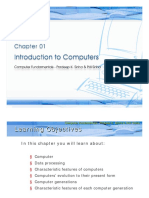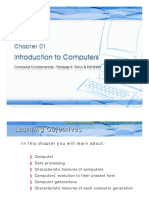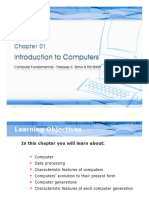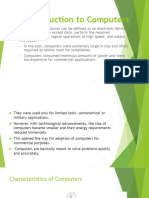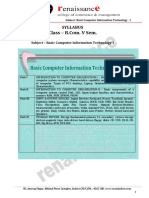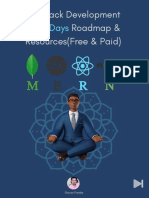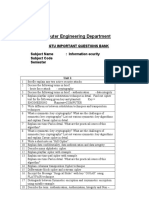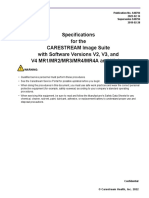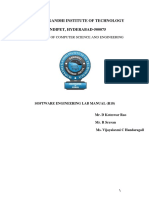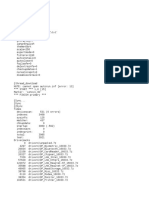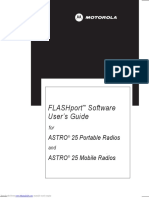Introduction to
Computers
FUNDAMENTALS OF COMPUTING Syllabus
Objective: The objective of the paper is to facilitate the student with applied working knowledge of computers. This is the first course of computing and does
not assume any pre-requisite.
UNIT-I
Five Component Model of a Computer, System and Application software ( introduction ) storage devices , primary (RAM, ROM, PROM, EPROM, cache )
Memory and secondary (magnetic tape, hard disk, Compact disks) memory , peripheral devices , printers. [T1], [T2][8 Hours]
UNIT-II
Operating Systems: DOS Internal, External commands, Windows ( 2000 and NT) , Overview of architecture of Windows, tools and system utilities including
registry , partitioning of hard disk , Overview of Linux architecture , File system , file and permissions , concept of user and group , installation of rpm and
deb based packages. [T1], [T2][8 Hours]
UNIT-III
Basics of programming through flow chart , Networking Basics - Uses of a network and Common types of networks , Network topologies and protocols ,
Network media and hardware , Overview of Database Management System. [T1],[T2],[R1][8 Hours]
UNIT-IV
Libre / Open Office Writer : Editing and Reviewing, Drawing, Tables, Graphs, Templates Libre / Open Office Calc : Worksheet Management , Formulas,
Functions, Charts Libre / Open Office Impress: designing powerful power-point presentation [R2][R3] [8 Hours]
Text:
[T1] Peter Norton, Introduction to computers, Sixth Edition Tata McGraw Hill (2007).
[T2] Andrews Jean, A+Guide to Managing & Maintaining Your PC, Cengage Publication 6/e
References:
[R1] Anita Goel, Computer Fundamentals, Pearson Education.
[R2] Joiner Associates Staff, Flowcharts: Plain & Simple: Learning & Application Guide , Oriel Inc
[R3] http://www.openoffice.org/why/
[R4] http://www.libreoffice.org/get-help/documentation/
Computer Fundamentals: Pradeep K. Sinha & Priti Sinha
Learning Objectives
In this chapter you will learn about:
Computer
Data processing
Characteristic features of computers
Computers’ evolution to their present form
Computer generations
Characteristic features of each computer generation
Ref Page 01 Slide 3/17
Computer Fundamentals: Pradeep K. Sinha & Priti Sinha
Computer
The word computer comes from the word “compute”,
which means, “to calculate”
Thereby, a computer is an electronic device that can
perform arithmetic operations at high speed
A computer is also called a data processor because it can
store, process, and retrieve data whenever desired
Ref Page 01 Slide 4/17
Computer Fundamentals: Pradeep K. Sinha & Priti Sinha
Data Processing
The activity of processing data using a computer is
called
data processing
Data
Capture Data
Manipulate Data
Output Results
Information
Data is raw material used as input and information is
processed data obtained as output of data
processing
Ref Page 01 Slide 5/17
Computer Fundamentals: Pradeep K. Sinha & Priti Sinha
Characteristics of Computers
1) Automatic: Given a job, computer can work on it
automatically without human interventions
2) Speed: Computer can perform data processing jobs
very fast, usually measured in microseconds (10-6),
nanoseconds (10-9), and picoseconds (10-12)
3) Accuracy: Accuracy of a computer is consistently high
and the degree of its accuracy depends upon its design.
Computer errors caused due to incorrect input data or
unreliable programs are often referred to as Garbage-
In-Garbage-Out (GIGO)
(Continued on next slide)
Ref Page 01 Slide 6/17
Computer Fundamentals: Pradeep K. Sinha & Priti Sinha
Characteristics of Computers
(Continued from previous slide..)
4) Diligence: Computer is free from monotony, tiredness,
and lack of concentration. It can continuously work for
hours without creating any error and without grumbling
5) Versatility: Computer is capable of performing almost
any task, if the task can be reduced to a finite series of
logical steps
6) Power of Remembering: Computer can store
recall any and
amount of information because of its
secondary storage capability. It forgets or looses certain
information only when it is asked to do so
(Continued on next slide)
Ref Page 01 Slide 7/17
Computer Fundamentals: Pradeep K. Sinha & Priti Sinha
Characteristics of Computers
(Continued from previous slide..)
7) No I.Q.: A computer does only what it is programmed
to do. It cannot take its own decision in this regard
8) No Feelings: Computers are devoid of emotions. Their
judgement is based on the instructions given to them in
the form of programs that are written by us (human
beings)
(Continued on next slide)
Ref Page 01 Slide 8/17
Computer Fundamentals: Pradeep K. Sinha & Priti Sinha
Evolution of Computers
Blaise Pascal invented the first mechanical adding
machine in 1642
Baron Gottfried Wilhelm von Leibniz invented the
first
calculator for multiplication in 1671
Keyboard machines originated in the United States
around 1880
Around 1880, Herman Hollerith came up with the concept
of punched cards that were extensively used as input
media until late 1970s
Ref Page 01 Slide 9/17
Computer Fundamentals: Pradeep K. Sinha & Priti Sinha
Evolution of Computers
(Continued from previous slide..)
Charles Babbage is considered to be the
father of modern digital computers
He designed “Difference Engine” in 1822
He designed a fully automatic analytical engine in
1842 for performing basic arithmetic functions
His efforts established a number of principles that
are fundamental to the design of any digital
computer
(Continued on next slide)
Ref Page 01 Slide 10
/17
Computer Fundamentals: Pradeep K. Sinha & Priti Sinha
Some Well Known Early Computers
The Mark I Computer (1937-44)
The Atanasoff-Berry Computer (1939-42)
The ENIAC (1943-46)
The EDVAC (1946-52)
The EDSAC (1947-49)
Manchester Mark I (1948)
The UNIVAC I (1951)
Ref Page 03
Computer Fundamentals: Pradeep K. Sinha & Priti Sinha
Computer Generations
“Generation” in computer talk is a step in technology. It
provides a framework for the growth of computer industry
Originally it was used to distinguish between various
hardware technologies, but now it has been extended to
include both hardware and software
Till today, there are five computer generations
(Continued on next slide)
Ref Page 03
Computer Fundamentals: Pradeep K. Sinha & Priti Sinha
Computer Generations
(Continued from previous slide..)
Key hardware Key software Key Some
Generation
representative
(Period) technologies characteristics systems
technologies
First Vacuum tubes Machine Bulky in size ENIAC
(1942-1955) Electromagnetic and assembly Highly unreliable EDVAC
relay memory languages Limited EDSAC
Punched Stored commercial use and UNIVAC I
cards secondary program concept costly IBM 701
storage Mostly Difficult
scientific commercial production
applications Difficult to use
Second Transistors Batch Faster, smaller, more Honeywell 400
(1955-1964) Magnetic operating system reliable and easier to IBM 7030
cores memory High-level program than previous CDC 1604
Magnetic tapes programming generation systems
UNIVAC LARC
Disks for secondary languages Commercial production
storage Scientific was still difficult and
and commercial costly
applications
(Continued on next slide)
Ref Page 03
Computer Fundamentals: Pradeep K. Sinha & Priti Sinha
Computer Generations
(Continued from previous slide..)
Generation Key hardware Key software Key Some rep.
(Period) technologies characteristics systems
technologies
Third ICs with SSI and Timesharing Faster, smaller, more IBM 360/370
(1964-1975) MSI operating reliable, easier and PDP-8
technologies system cheaper to produce PDP-11
Larger magnetic Standardization Commercially, easier
CDC 6600
cores memory of high-level to use, and easier
Larger capacity programming to upgrade than
disks and languages previous generation
magnetic tapes Unbundling of systems
secondary software Scientific, commercial
storage from and interactive on-
Minicomputers; hardware line applications
upward
compatible family
of computers
(Continued on next slide)
Ref Page 03
Computer Fundamentals: Pradeep K. Sinha & Priti Sinha
Computer Generations
(Continued from previous slide..)
Generation Key hardware Key software Key Some rep.
(Period) characteristic systems
Technologies technologies s
Fourth ICs with Operating systems for Small, affordable, IBM PC and
(1975-1989) VLSI technology PCs with GUI and reliable, and easy its clones
Microprocessors; multiple windows on a to use PCs Apple II
semiconductor memory single terminal screen More powerful TRS-80
Larger capacity hard Multiprocessing and VAX 9000
disks as in-built OS with reliable
CRAY-1
secondary storage concurrent mainframe
programming systems CRAY-2
Magnetic tapes and
floppy disks as portable languages and CRAY-X/MP
storage media UNIX operating system supercomputers
Personal computers with C programming Totally
Supercomputers based language general purpose
Object-oriented design machines
on parallel
vector processing and programming Easier to produce
and symmetric PC, Network-based, commercially
multiprocessing and supercomputing Easier to upgrade
technologies applications Rapid
Spread of high- software
speed computer development
networks possible (Continued on next slide)
Ref Page 03
Computer Fundamentals: Pradeep K. Sinha & Priti Sinha
Computer Generations
(Continued from previous slide..)
Generation Key hardware Key software Key Some rep.
(Period) technologies characteristics systems
technologies
Fifth ICs with ULSI Micro-kernel based, Portable computers IBM notebooks
(1989- technology multithreading, Powerful, cheaper, Pentium PCs
Presen Larger capacity distributed OS reliable, and easier SUN
t) main memory, Parallel to use desktop Workstations
hard disks with programming machines IBM SP/2
RAID support libraries like MPI & Powerful SGI Origin
Optical disks as PVM supercomputers 2000
portable read-only JAVA High uptime due to
PARAM
storage media World Wide Web hot-pluggable
10000
Notebooks, Multimedia, components
powerful Internet Totally
desktop PCs applications general purpose
and More machines
workstations complex Easier to
Powerful supercomputing produce
servers, applications commercially,
supercomputers easier to upgrade
Internet Rapid
Cluster computing software
development
possible
Ref Page 03
Computer Fundamentals: Pradeep K. Sinha & Priti Sinha
Electronic Devices Used in Computers of Different Generations
(a) A Vacuum Tube (b) A Transistor (c) An IC Chip
Ref Page 03
Computer Fundamentals: Pradeep K. Sinha & Priti Sinha
Key Words/Phrases
Computer Integrated Circuit (IC)
Computer generations Large Scale Integration (VLSI)
Computer Supported Cooperative Medium Scale Integration (MSI)
Working (CSCW) Microprocessor
Data Personal Computer (PC)
Data processing Second-generation computers
Data processor Small Scale Integration (SSI)
First-generation computers Stored program concept
Fourth-generation computers Third-generation computers
Garbage-in-garbage-out (GIGO) Transistor
Graphical User Interface (GUI) Ultra Large Scale Integration
Groupware (ULSI)
Information Vacuum tubes
Ref Page 03

